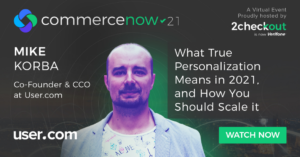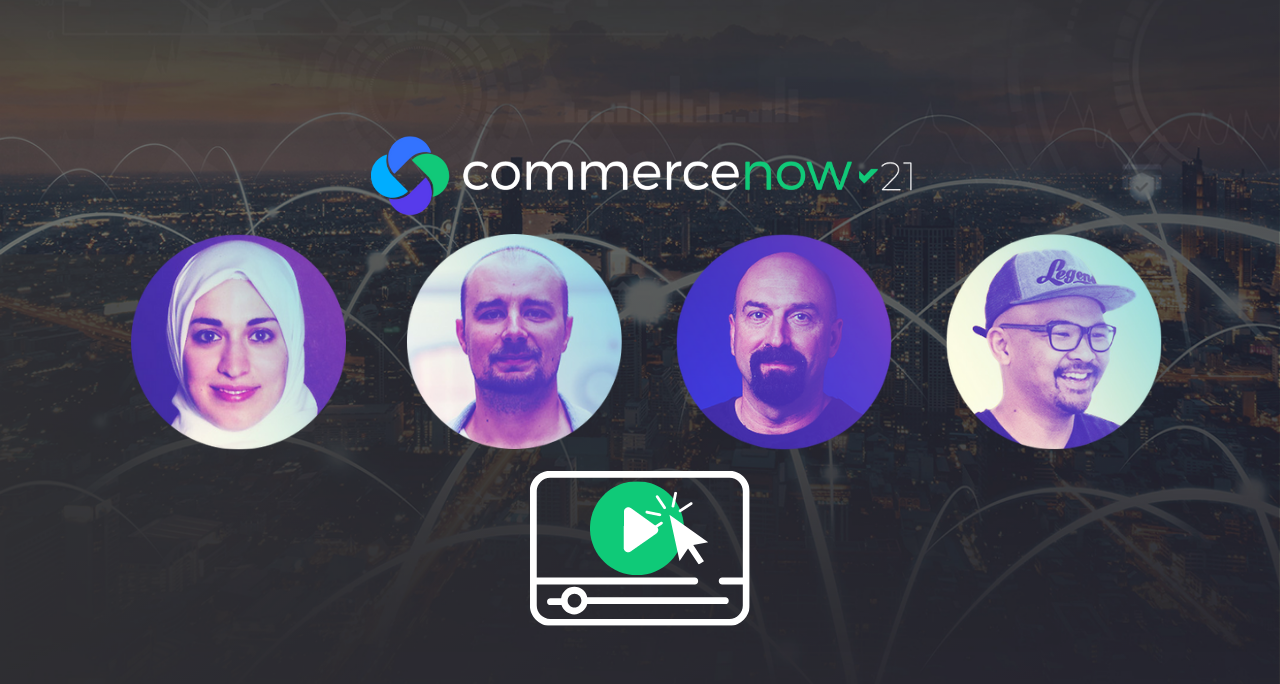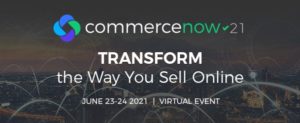The past two years have brought about astonishing shifts in our world, with the effects of the COVID-19 pandemic and its necessary restrictions influencing nearly everything – including online business.
With these unusual global circumstances as the backdrop, 2Checkout’s fifth CommerceNow 2021 online event this past June was particularly useful to participants, sharing timely presentations from some of the greatest minds in eCommerce, digital marketing, conversion rate optimization, customer retention, global payments, and more.
This blog article will share some of the key takeaways from four of the CommerceNow ’21 presentations, all around improving customer retention. You may also register to watch all the recorded webcasts here.
Takeaways:
- Understanding the social and emotional triggers of your customers will help you stand out.
- True personalization is essential for improving retention, and requires segmentation (“to whom”) and a deep understanding of context (“when”) and channel/way (“how”).
- Remember that your customer is a person, not just a number.
- While targeting the right customers is a prerequisite for high retention rates, onboarding also plays a big role: it sets up users to love your product (if effective) or leave for good (if not).
Ayat Shukary, co-founder of Invesp Consulting, shared her recommendations for finding what really triggers and motivates your customers, in her presentation “Tips to Get into the Brains of Your Site Visitors.”

“People don’t want your product,” Ayat emphasized. “They want the satisfaction that your product brings.” The biggest mistake businesses make, she said, is trying to compete on features and price to stand out, instead of working with the social and emotional touchpoints of their customers which will make their product stand out – and result in its sale.
In-depth qualitative research is the answer, Ayat said, to get at the conscious and subconscious reasons that drive your customers’ needs. “Personas—biography, age, job, marital status—these are important to consider, but to stand out, we need to look beyond these personas.” Qualitative research methods are essential, she continued, and can vary from one-one-one interviews and focus groups to usability studies and surveys.
Ayat referred to The Job to be Done Theory, with “job” defined as the progress a person is trying to make in a particular circumstance. “The premise of the customer interview is to understand what that desired progress is,” she pointed out. “You have ‘how things are today’ and ‘how I want them to be’; the gap in the middle is your product or service that can be provided.”
Ayat broke down the qualitative research into three steps:
- Segmentation, where you’re seeking to understand who you’re targeting and what their functional, social, and emotional needs are;
- The research itself, which can consist of interviews and correlation of the info they provide, followed by targeted polls;
- The analysis of the results: what pushed them to pick my product? What were their anxieties? What habits did they have that reinforced their choice?
“Whenever I do this research, I’m trying to unlock the right information to get higher conversions,” Ayat emphasized. “The ultimate goal of all this is to satisfy current customers and attract new ones.”
If you want more tips on how to uncover the consumers’ real motivations when using a product, and get happier customers with high retention rates, then make sure to watch Ayat’s full session here.
Mike Korba, co-founder and CCO of User.com presented his retention tips in his presentation “What True Personalization Means in 2021, and How You Should Scale it.”

“Personalization is not just using the user’s personal name. People know that no one wrote this manually. Not enough,” Mike proclaimed as he began his talk. “True personalization means three things: segmentation (to whom), context (when) and channel/way (how).”
Starting with segmentation, Mike described how you take a group of your customers/leads/subscribers, find similar attributes, and then group them into buckets.
There are numerous aspects to segment by: purchasing behavior, customer journey stage, interests, engagement level, etc. Then, using a customer data platform where you can store all data and touchpoints, he said, you segment based on data type:
1. Data about customers (attributes)
- Industry or stage of development
- Technology they use
- Size of company
- Stage of evolution
- Country
2. Data about activity of customers (events)
- Conversion stage
- Level of engagement
- Source of acquisition
- Specific activities (downloading an eBook or video)
3. Revenue data (company/deal attributes)
- LTV
- What kind of plan did the customer choose?
- Who are the most profitable customers, and which ones are going to close the deals faster?
Moving on to personalization by context, Mike said simply that where the customer is in the funnel determines other marketing communications you’ll deploy.
Finally, he recommends to also personalize by channel, carefully considering how you will communicate, whether by email, SMS, push notifications, ad campaign, etc. while also prioritizing tone of voice: messages from the company should be more formal, while others from departments or team members can be more casual and accessible.
Channels can be mixed and matched but it’s wise to synchronize. He also pointed out that video can now be used in really creative ways, even in later stages of the funnel, and has been shown to be tremendously successful in the journey to retention.
Want more insights into personalization?
Watch Mike’s full session to understand the importance of personalizing your customer’s journey and its impact on client retention.
“Focus on the Customer as a Person” was a great session presented by Alexander Genov, head of customer research at Zappos, where he emphasized that, when striving for long-term retention success, you should have the mindset that the customer is the hero.

Alexander broke down the work of customer-centricity into four parts:
1. Culture. He describes ten values that will build customer loyalty, including “deliver WOW through service,” “be adventurous, creative, and open-minded,” “do more with less,” and “be humble.” To build this culture, he recommended:
- Identifying company and team core values
- Involve all employees and team members in process
- Put core values into practice, not just posters in the hallway.
2. Customer curiosity. “When you dig deeper, you uncover really interesting aspects of people that can be meaningful to your business,” Alexander said. Get a 360-degree view, he continued, by having your data science team analyze the data and another team figure out why customers are doing what they’re doing. Investigate the following:
- Customer mindset segmentation
- Shopping transaction data
- Customer service data
- Phone interviews
- Home visits.
3. Structure. Organize your team around the work, not around the individuals on the organization chart, and give accountability to the employees involved, Alexander recommended.
4. Strategy. “Don’t treat all your customers the same,” he said. “Segmentize your customers by type in order to personalize their experience.” Take the following steps:
- Talk to your customers
- Consolidate your data into one place
- Conduct simple data analyses
- Communicate the insights across silos.
“The most important message is that customers are people,” Alexander emphasized. “When you treat them like numbers, it’s easy to lose sight of loyalty.”
Want to learn more about the customer-centric culture?
Then you should definitely watch Alexander’s full session here.
Ramli John, managing director at ProductLed, addressed the importance of onboarding for customer retention in his presentation “How to Turn Casual Shoppers into Lifetime Customers.”

“Product-led onboarding is essential to growth,” Ramli began. “Your company’s growth depends on first impressions, and if your first impression is great, there’s a higher chance that customers will come back again and again. Data backs this.”
Unfortunately, he pointed out, 40 to 60% of first-time users sign in once and never log in again. Why? “User onboarding is a race against time; the longer it takes to discover the value of the product or service, the more likely they will drop off.”
“You have to make your product’s time-to-value as small as possible,” Ramli continued. He referred to the Bowling Alley Framework, with the ideal scenario being a user strike via straight-line onboarding.
Ramli shared his 4-step process to improve onboarding:
- Identify user success: why are they signing up? In what ways are they signing up? In what ways do they upgrade when they use your product (could be functionally, emotionally, or socially influenced)?
- Map out the user onboarding journey, step by step. There are tools that can help you do this.
- Vet every step—what can you eliminate or delay? Which steps are mission critical?
- Develop your straight-line onboarding experience.
User onboarding, Ramli asserted, sets up users to love your product, or to leave it for good. To turn your customers into lifelong users, Ramli recommended his 6-step Eureka Framework:
- Establish an onboarding team
- Understand your end users
- Refine your onboarding success milestones
- Evaluate and optimize the new user’s journey
- Keep new users engaged
- Analyze the results, and repeat.
Want to find out all the secrets behind product-led onboarding and lifetime customers?
Watch Ramli’s entire session for more in-depth insights.
View these and additional CommerceNow 2021 presentations to learn more about the newest trends, insights, tips and tricks from some of the greatest minds in the industry – the full event can be viewed here.






